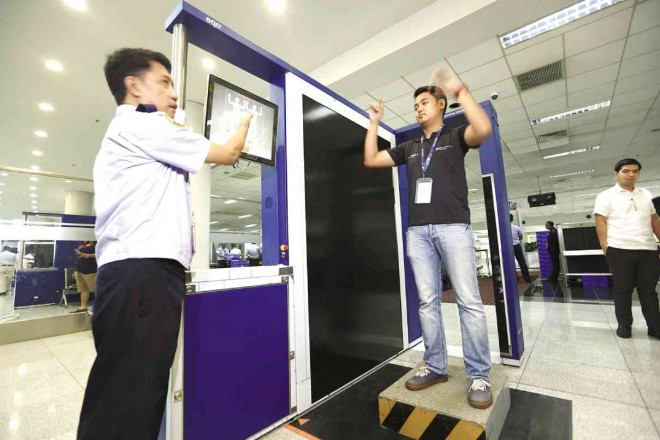A month later, P150M Naia body scanners still unused

IDLE ASSETS After the initial demo as shown in this Aug. 11, 2015, file photo, the 14 full-body scanners costing P150 million have not been used at any of the four Naia terminals as many airport personnel have yet to learn how to operate the equipment. Edwin Bacasmas
Full-body scanners bought last month by airport authorities and installed at the Ninoy Aquino International Airport (Naia) have remained unmanned and unused.
The 14 full-body scanners, more specifically the German-made EQO model portals worth P150 million, were installed in August at the final security screening checkpoints of the four Naia terminals.
But the EQO model portals remain idle up to now since Office for Transportation Security (OTS) personnel have yet to undergo training on their proper use. Only members of the OTS, an attached agency of the Department of Transportation and Communications (DOTC), are authorized to handle security screening equipment at the country’s ports, including the Naia.
A source from the Manila International Airport Authority (MIAA) said the local distributor of the EQO model portals, Defense and Protection System Philippines Inc. (DPSPI), organized last week a training session for DOTC-OTS personnel, members of the Airport Police Department and other technical staff.
However, the source said none of the DOTC-OTS personnel attended the training, prompting MIAA to push for a seminar organized solely for its employees. The DPSPI agreed and scheduled a seminar this week.
The apparent reluctance to handle the 14 full-body scanners procured by the MIAA, the source pointed out, could have something to do with the fact that the DOTC-OTS procured eight full-body scanners in February from Singapore which were delivered in the last week of July. These were supposed to be installed at the Naia.
No detection in 1st tests
Asked why they have not been used at the Naia, the source said: “Because when they (eight full-body scanners bought by DOTC-OTS) were initially tested, they could not detect anything,” adding that the equipment seemed to be of poor quality.
He explained that for that reason, the DOTC-OTS could not roll out at the Naia their scanning equipment for which it paid P50 million.
“The equipment arrived a week or two ahead of those procured by the MIAA so you can already see why they hesitated to set their scanners up at the Naia. It’s so their scanners won’t be compared with that of Miaa’s,” he said.
DOTC-OTS spokesman Jonathan Maliwat told the Inquirer that the eight passive millimeter wave scanners they procured were distributed to the Clark International Airport; Laoag International Airport; Kalibo International Airport; and Iloilo International Airport.
Two of the scanners, he said, had to be realigned to the Cebu International Airport.
Asked why these were not set up at the Naia as initially planned, Maliwat said the scanners were portable so they were easy to move from one airport to another depending on the necessity.
No more frisking
During the procurement process for the eight scanners worth P6 million each, the DOTC-OTS announced that the equipment would be installed at the Naia Terminals 1, 2 and 3 as well as at the Mactan-Cebu and Davao International Airports to do away with the frisking of passengers.
In a statement issued in February, the DOTC-OTS said its procured equipment could detect objects under people’s clothes without invading their privacy.
Similarly, the MIAA-procured EQO model portals manufactured by German company Smiths Detection, bounce harmless millimeter waves (low frequency radiation) off passengers’ bodies and analyze the reflected data using a generic outline graphic to highlight detected items, both metallic and nonmetallic.
The EQO model portals have been set up at the final security screening checkpoints of the four Naia terminals: three in Terminal 1; five in Terminal 2; five in Terminal 3; and one in Terminal 4.














